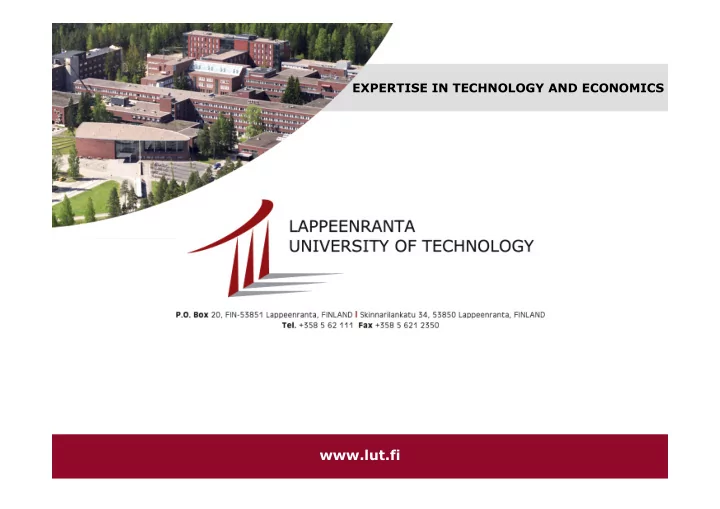

������������������������������������� ����������
High temperature and hot air drying of birch timber Veikko Möttönen and Timo Kärki
�������� Background Objectives Water movement above FSP during high temperature (HT) drying Effect of different HT drying schedules on wood colour Discussion and conclusions
�� !"#���$ Typically, birch timber is dried conventionally at low temperature for 3-4 weeks or at vacuum Uneven discolouration (darkening and increasing of redness) of birch wood is a problem with all artificial drying methods Discolouration occurs in the core of timber pieces while the outer layer remains light
�� !"#���$ Discolouration of birch wood is dependent on drying temperature and time Discolouration seems to develop above the fiber saturation point of wood (FSP) High temperature drying, (T d >100° C) produces dark coloured and reddish birch timber if steam is used for the heat transfer On the other hand, drying quality has been good at high temperature with compression drying
�%&� ��'�� To study the water movement in wood above FSP in order to clarify the physical mechanism of the colour change at high temperature To study the effect of different drying schedules at high temperature on discolouration of birch sawn timber
(���#�)�'�)�����%�'��*�� Water movement above the FSP was detected using a dye (pyranine) solution injected in boards at different distances from the board end Pyranine is a hydrophilic, fluorescent dye The boards (25 mm × 100 mm × 1400 mm) were HT-dried The trace of the dye solution was analysed from images of sliced or split-sawn boards
(���#�)�'�)�����%�'��*�� Dye solution was injected in a borehole from the side of the board at the distance of 20, 40 or 60 cm from the board end The borehole was sealed with wooden tap and glue before drying ������ �������
(���#�)�'�)�����%�'��*�� Cross-sectional trace of the dye solution at 2.5 cm steps along the board ��������� ����� �����
(���#�)�'�)�����%�'��*�� Cross-sectional trace of the dye solution at 2.5 cm steps along the board ��������� ����� �����
(���#�)�'�)�����%�'��*�� Cross-sectional trace of the dye solution at 2.5 cm steps along the board ��������� ����� �����
(���#�)�'�)�����%�'��*�� ��������� ����� ����� Longitudinal trace of the dye solution in the core of split- sawn boards
�����#�������$#+��"�� ,�$�������$����$� ����# Wood material 25 × 100 and 50 × 100 mm 2 , length 1000 mm Drying schedules 1. HT at 120° C, without steaming, 24-36 hours 2. hot air at 120° C using ventilation to increase the wet bulb depression, 24-36 hours 3. combination of low temperature (LT) at 65-85° C and hot air at 105° C in order to use low temperature above FSP and high temperature below FSP, LT: 3 and 6 days for 25 and 50 mm boards, respectively, hot air: 6 and 12 hours for 25 and 50 mm boards, respectively. With 25 mm thick material normal drying using stickers and contact drying were compared for hot air drying schedule
�����#�������$#+��"�� ,�$�������$����$� ����# CIEL*a*b* colour values were measured with a spectrophotometer L* lightness a* redness b* yellowness 2 2 ) 2 ( ) ( ) ( ∆ E * = ∆ L * + ∆ a * + ∆ b * Colour difference ab � E ab * of approximately 2 can be distinguished by human eye Colour values were measured from the core and from the surface layer of boards after the samples were split-sawn and planed
�����#�������$#+��"�� ,�$�������$����$� ����# ���������������� ���������������������������������� 1. HT drying 2. LT + hot air drying 3. Hot air drying L* 71.5 74.0 76.3 a* 8.1 6.0 6.5 b* 17.2 18.6 16.7 � E ab * Between 1 & 2 Between 1 & 3 Between 2 & 3 3.6 5.1 3.0
�����#�������$#+��"�� ,�$�������$����$� ����# Examples of 25 mm thick boards 1. HT-dried 2. LT+hot-air-dried 3. hot-air-dried
�����#�������$#+��"�� ,�$�������$����$� ����# ���������������� ���������������������������������� 1. HT drying 2. LT + hot air drying 3. Hot air drying L* 68.1 71.1 73.0 a* 10.1 7.9 7.1 b* 17.7 19.4 17.8 � E ab * Between 1 & 2 Between 1 & 3 Between 2 & 3 4.4 6.1 2.6
�����#�������$#+��"�� ,�$�������$����$� ����# Examples of 50 mm thick boards 1. HT-dried 2. LT+hot-air-dried 3. hot-air-dried
�����#�������$#+��"�� ,�$�������$����$� ����# Difference in colour �� �� �� Drying 25 mm 50 mm between the surface layer schedule boards boards and the core of boards HT 6.7 9.3 LT+hot air 5.5 4.8 Hot air 2.3 4.5
�����#�������$#+��"�� ,�$�������$����$� ����# Comparison between drying Colour Stickers Contact on stickers and in contact variable with metal plate L* 75.4 77.2 �� �� ������� a* 6.9 6.0 b* 17.1 16.3
��� ���������$� �� ������ According to the test with the dye solution, the cross-sectional flow of capillary water is very small compared to that in longitudinal direction Thus, the drying of the core of sawn timber takes considerable more time than the drying of the surface layer � the main reason for the discolouration of wood
��� ���������$� �� ������ Hot air drying gave the lightest and the least red and yellow wood compared to HT and combined drying schedule To avoid the discolouration of wood drying process should be as fast as possible above the FSP Methods to accelerate the drying process should be developed, e.g. contact drying
Recommend
More recommend